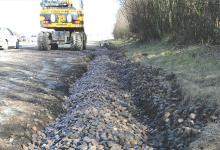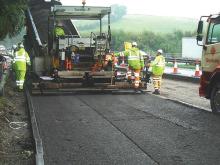
Use of secondary aggregates can help boost recycling rates but added legislation is bringing higher costs. Julie-Anne Ryan reports
The need for sustainable resources is an increasingly forceful driver for any manufacturing industry, and nowhere more so than in the production of aggregates. Recycling is an obvious and established part of most business plans in the field, and the use of secondary aggregates - usually the by-products of non-construction industrial processes - is adding a notable dimension to the force for environmentally sympathetic production.
At the moment, less than a third of the states in Europe produce secondary aggregates. Of those that do, Germany and the UK lead the way in relation to proportion of aggregate sales - indicating that they have already tackled and solved many of the problems that other states are still facing..
Every year, 275million tonnes of aggregates are produced for the construction industry in the UK -.
65million tonnes of which come from recycled or secondary sources.
It's estimated that the country will need another 20million tonnes of aggregates.
by 2012 - so, as with other member states, the industry will either have to meet the demand from more primary sources, or increase its efficiency in recovering secondary materials. .
Secondary aggregates can be natural, for example slate aggregate or china clay sand, but are more usually manufactured - various metallurgical slags, pulverised fuel ash, colliery shale or used foundry sand. Many secondary materials are from regional sources. For example, china clay sand comes from south west England, slate waste from North Wales, and metallurgical slag from South Wales, Yorkshire and Humberside. .
Different European states have similar localised sources. The use of locally sourced materials is an important contributor to the industries' sustainability - and the price of haulage is an important factor in profitability.
Legislation
Wherever and whatever the source, the diversity provides a wide base of useable materials, and as practical work continues through Europe to follow the UK's successful lead in preserving primary resources as much as possible, the legislation needed to support this part of the industry is becoming almost unwieldy.
John Barritt is construction market specialist at WRAP (
The administrative work of the guidelines, rules and regulations centres on what's waste and what's product. And at the heart of everything is the worthy doctrine that nothing should be produced that is harmful to the health, which is why it comes under the scope of REACH - the European Community Regulation on chemicals and their safe use. Or part of it does.
"The irony is that something that's waste is not covered by REACH, but once it becomes an aggregate it's covered," said Barritt..
As an example of the science of definition under REACH, one paragraph reads: "In determining the registration status of the recovered aggregates, information on the origin may be important in order to establish which constituents may be present in the material and whether they should be seen as impurity or separate substance. To identify the substances, that in principle, are subject to registration an analysis of the waste material will only be necessary insofar as constituents may in normal cases occur in quantities above 20% (or are intended to be present in the recovered material - however, in this case the recovery operator should know about their presence). The manufacturers of recovered aggregates should also have information on the identity and quantities in which hazardous minor constituents or impurities are present in the recovered aggregate to the extent needed as described in the section on impurities." Problems relating to various requirements over the next three or four years are expected: the Construction Products Directive; horizontal testing methods needing to be replaced; 'end of waste' criteria needing to be defined for different waste streams. The EU's Joint Research Centre Institute for Prospective Technological Studies said in its report End of Waste Criteria:
"As a result of the non-existence of environmental requirements for aggregates as a product and due to the fact that for a material to cease to be waste the principle of 'no overall adverse environmental or human health impacts' has to be met, environmental requirements for secondary and recycled aggregates have to redefined."
Financial implications
And it's all going to cost, said Barritt, something that will pose a problem in itself. Horizontal testing alone demands an obligation, and that is expensive. "I did 16 sites and it cost £93,000." He added: "It's easy enough to identify the levels of these materials, but assessing those risks ... can become subjective if you are not careful. So European aggregates standards are being changed to put in place these procedures and how you are going to compare levels relative to the use for which they are going to be applied.
"It's a problem across the board but it's going to be worse for secondary materials." Different mandates needed for different areas - the best known is the M125 from DG Enterprise to CEN - underline the complexity of the needs across the industry, across the different member states of the EU. The
"has now to work on sampling, leaching tests and criteria to be included in the future generation of harmonised aggregates product standards." .
It has also pledged to keep monitoring the developments on the Dangerous Substances issue and "will strive to ensure that any extra testing requirements for aggregates will be little or none".
"It can be mind-blowing but the impact can be enormous," said Barritt, who explained that the Aggregates Standards and Construction Products Directive come under DG Enterprise, while waste classification comes under DG Environment. The revised waste frameworks directive (2010), gave advice on regulations for end of waste. "There was no uniform statement before then and people were floundering. Now we have got this guidance on criteria it doesn't create as much waste as natural resources." So as the need for more secondary resources increases - and the attractiveness of using them throughout Europe becomes more attractive - so the burden of governing every aspect of this area of the industry grows more detail-rich. From gathering the material itself, applying the relevant processes and techniques, and considering the product requirements - through to quality control, safety and end use - every step needs to be analysed and defined so that specific end of waste conditions can be met..
"It's pretty frightening, because if you look at variability across member states, the breadth you have to cater for, the margins have to be so wide you can't use it," he said. "There are a lot of relative issues on environmental impact harmonising across Europe. We are going through a period of change, and a lot of drivers are positive because there is a desire to increase the use of materials. But the more we analyse the facts, the more issues tend to arise. So it takes longer.











